Heuristic Optimization of Consumer Electricity Costs Using a Generic Cost Model
Abstract
:1. Introduction
2. Related Work and Contribution
3. Optimization Model

3.1. Optimization Overview
3.2. Generic Cost Model
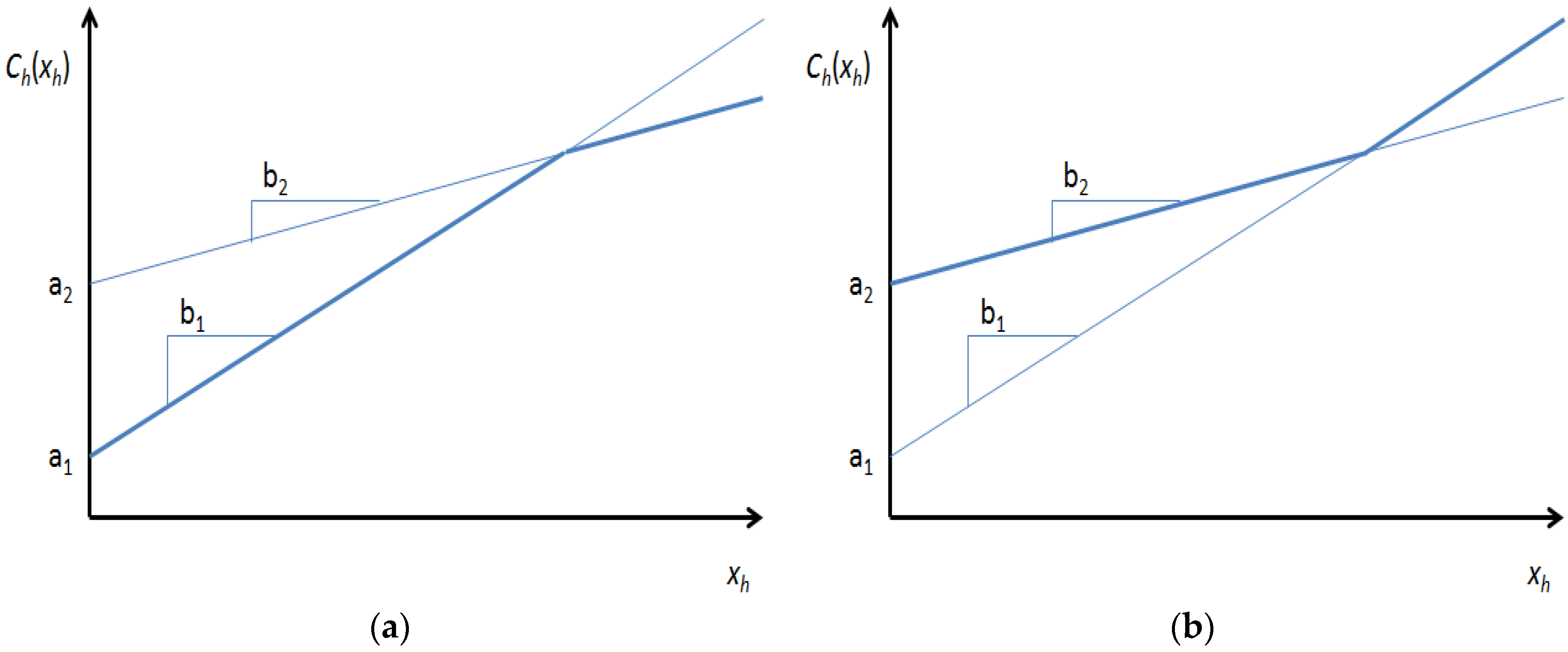
4. Scheduling Algorithms
4.1. Exact Method
1: Initialization: Set and initialize the N appliances, constraints and cost functions; 2: for i = 1 to N do 3: si := siMin; 4: end for; 5: CB := INF; 6: S := []; 7: Done := FALSE; 8: while Done == FALSE do 9: if Constraints Satisfied do 10: J := Evaluate Full Schedule Cost; 11: if J < CB do 12: CB := J; 13: S := [s1, s2, … sN]; 14: end if; 15: end if; 16: for i = 1 to N do 17: si := si + 1; 18: if si > siMax do 19: si = siMin; 20: if i == N do 21: Done=TRUE; 22: end if; 23: else 24: break; 25: end if; 26: end for; 27: end while; 28: return [CB, S];
4.2. Heuristic Method
1: Initialization: Set and initialize the N appliances, constraints and cost functions;
2: CB := 0;
3: S := [];
4: for i = 1 to N do
5: CB := CB + INF;
6: for si = siMin to siMax do
7: J := Evaluate Partial Schedule Cost;
8: if Constraints Satisfied
9: if J < CB
10: CB := J;
11: sB := si;
12: end if;
13: end if;
14: end for;
15: si := sB;
16: end for;
17: S := [s1, s2, … sN];
18: return [CB, S];
5. Simulation Studies
5.1. Minimum Cost Evaluation Based on Real-Time Energy Pricing (RTP)
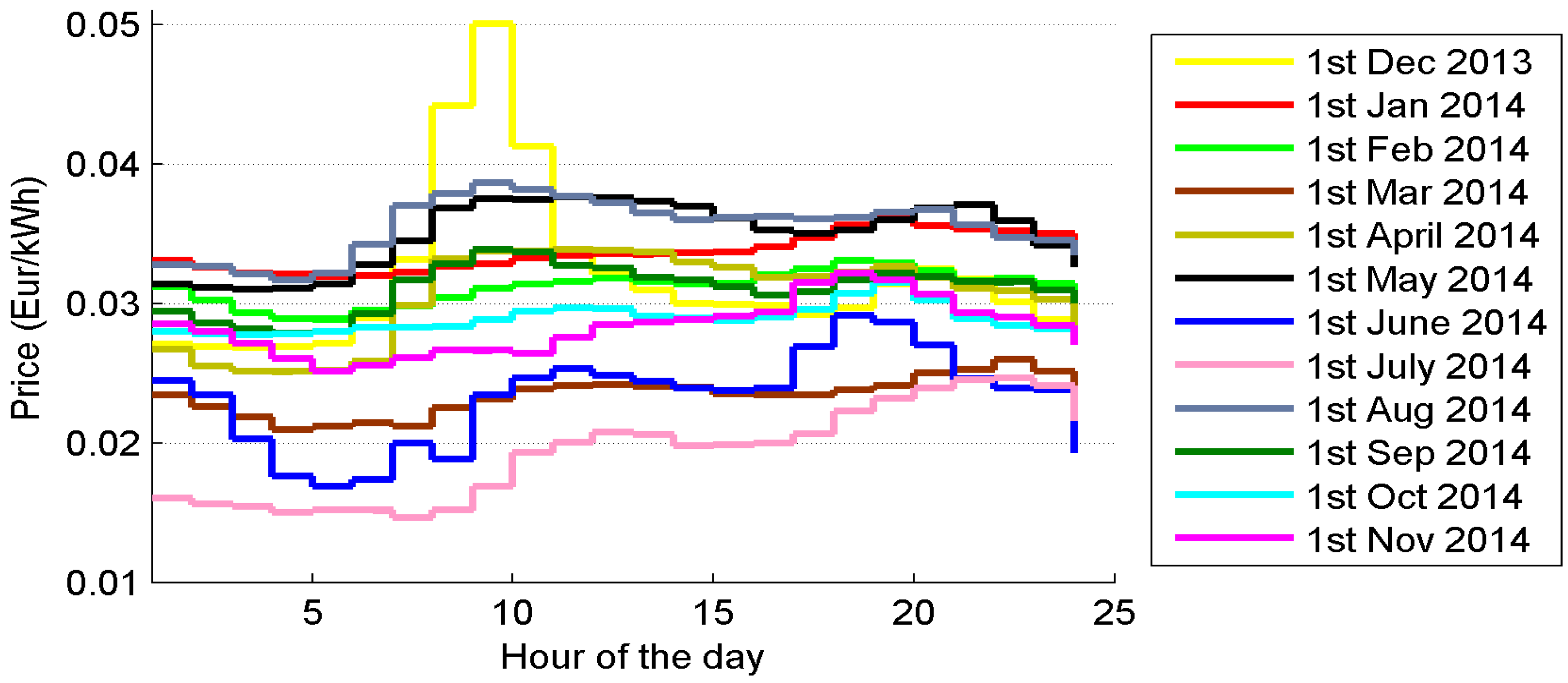
| Devices | Power Consumption (Watts) | User Time Preference |
|---|---|---|
| Washing machine | 2100 | 10:00–20:00 |
| Tumble dryer | 1200 | 10:00–22:00 |
| Dish washer | 1900 | 17:00–23:00 |
| Electric vehicle | 1000 | 1:00–5:00 |
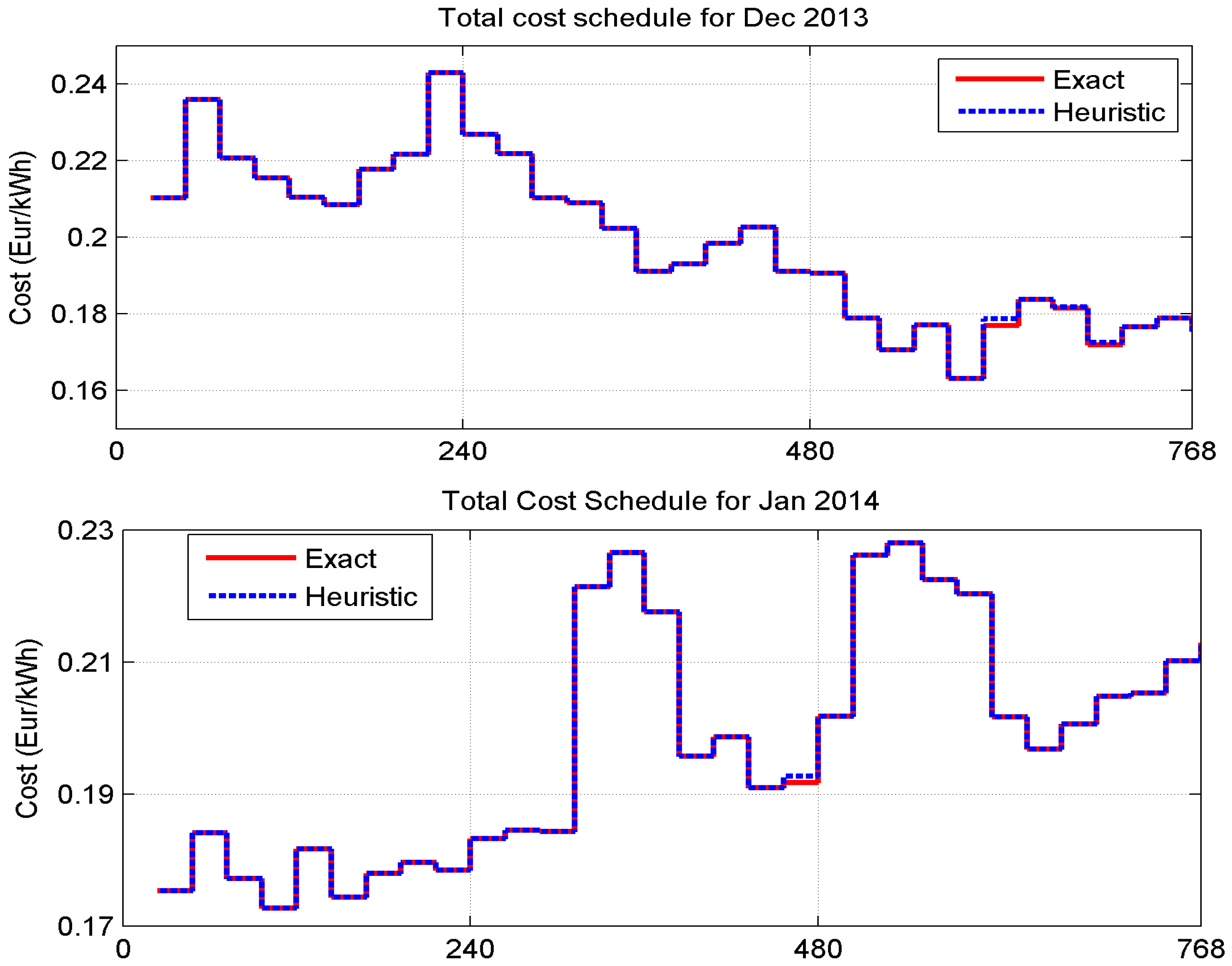
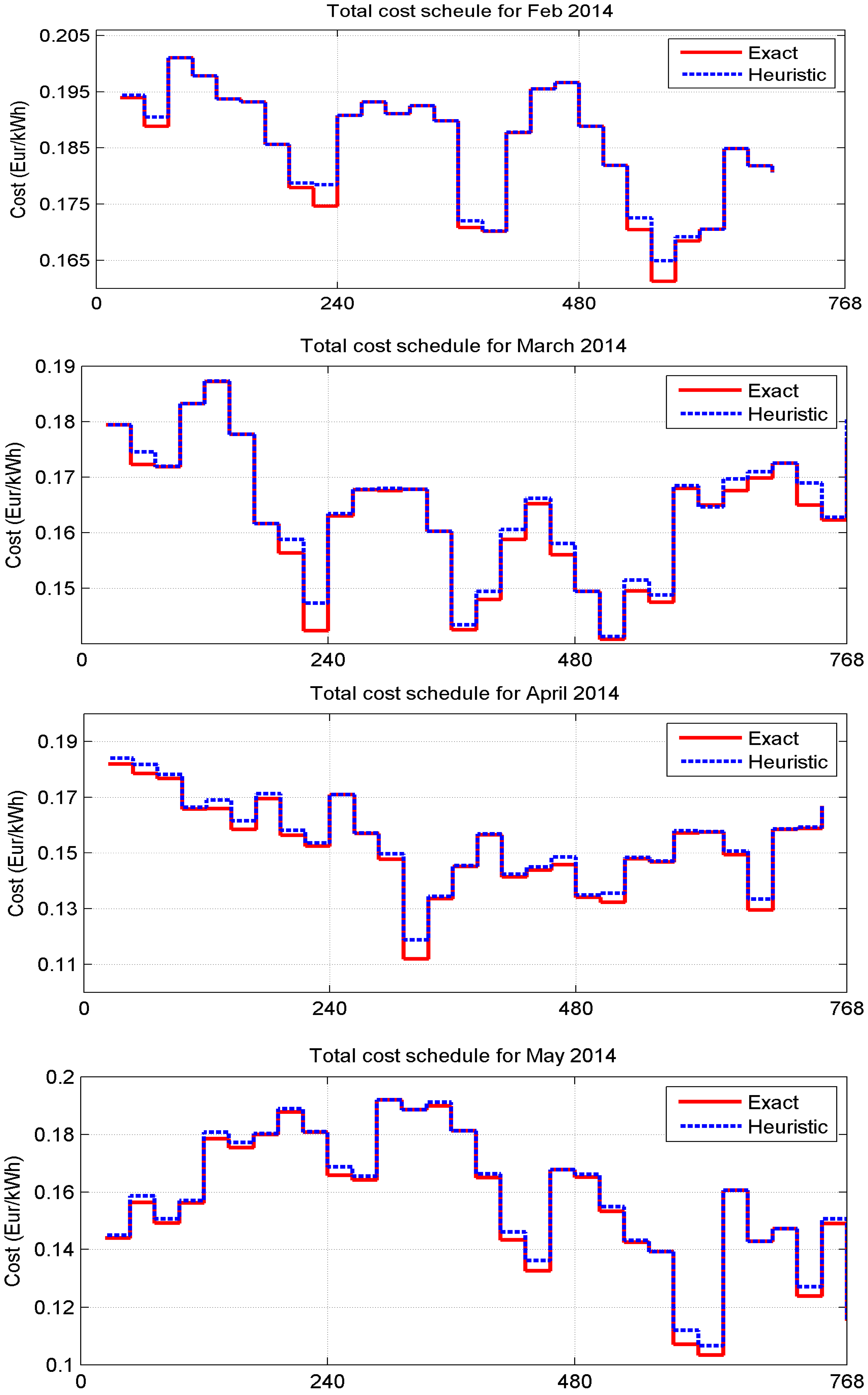
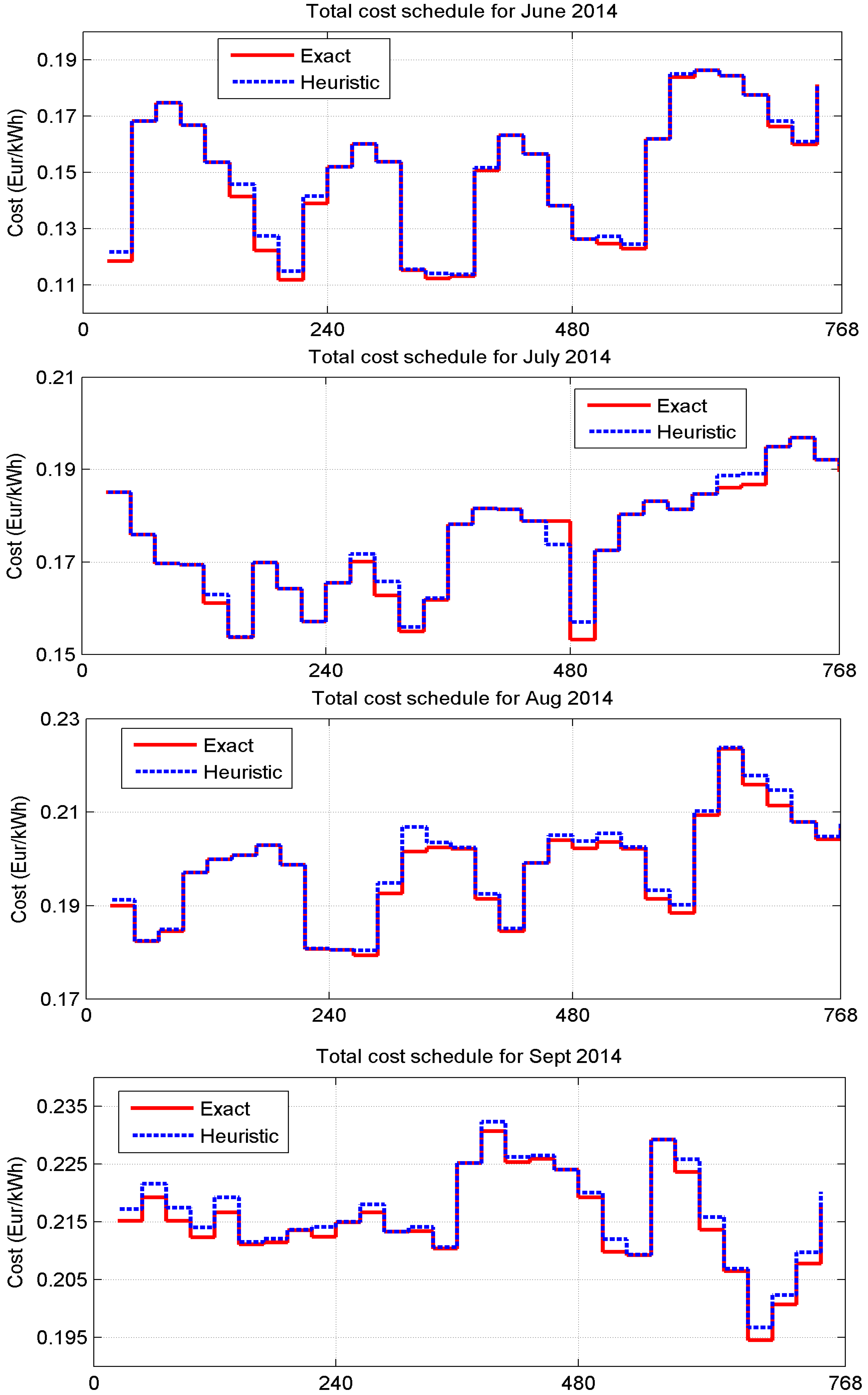
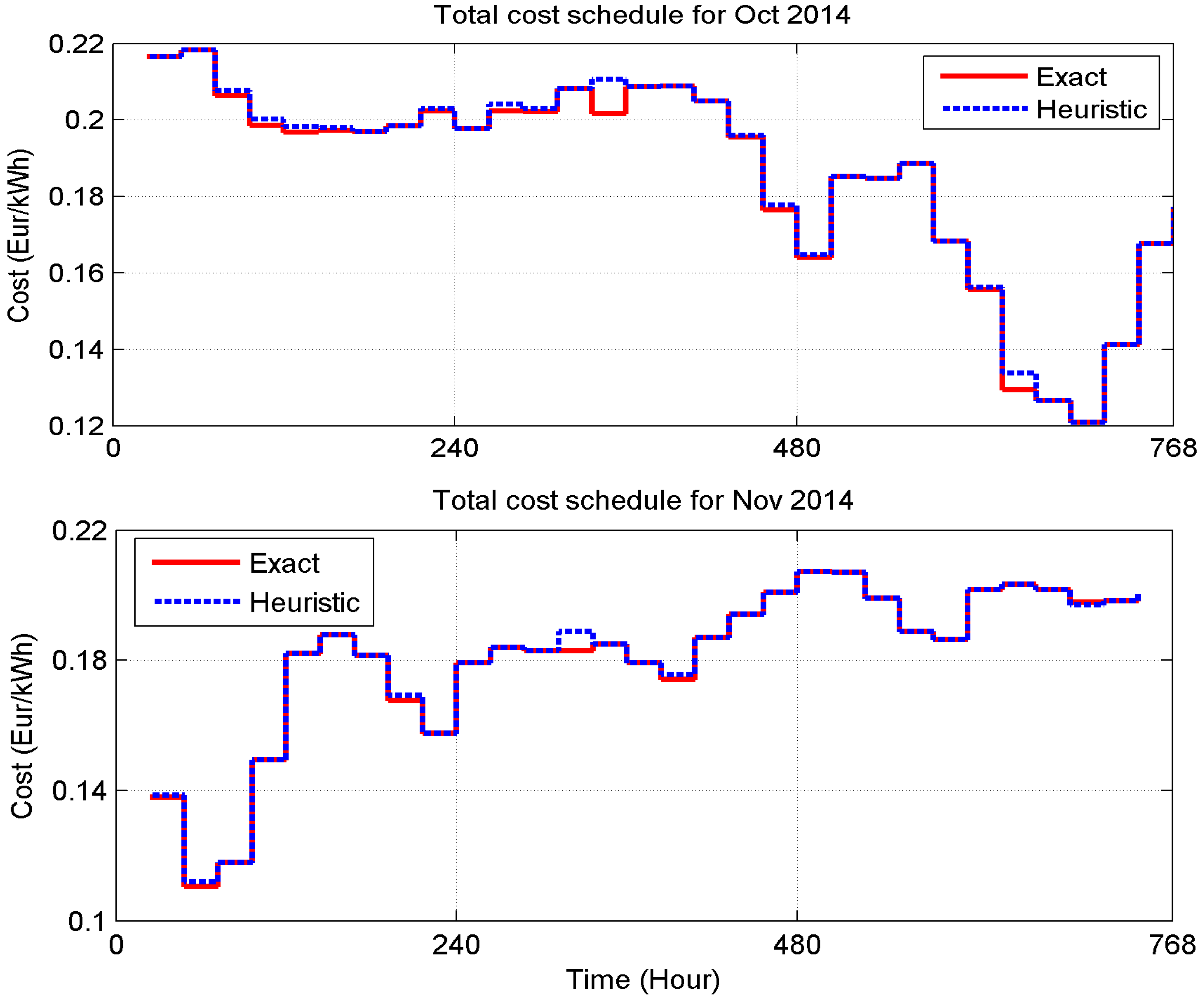
5.2. Cost Evaluation Based on Two-Tier Pricing (2TP)
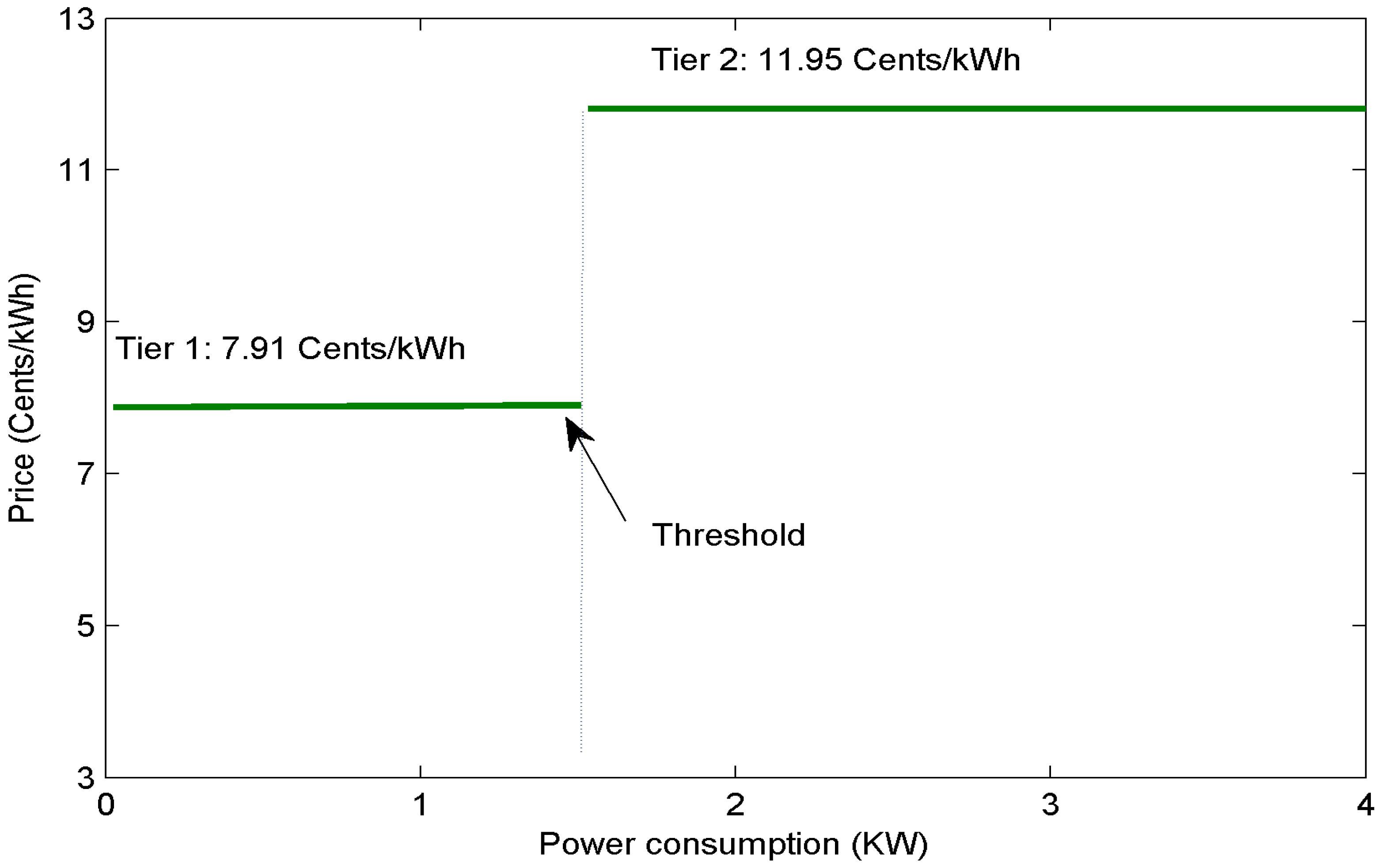
| Months of the Year (2014) | Heuristic Algorithm Average Total Cost (Eur/kWh) | Exact Algorithm Average Total Cost (Eur/kWh) | Relative Difference in Average Total Cost (%) |
|---|---|---|---|
| January | 0.46451 | 0.46221 | 0.00495 |
| April | 0.36140 | 0.35502 | 0.01765 |
| July | 0.40928 | 0.40461 | 0.00467 |
| October | 0.43770 | 0.43247 | 0.01195 |
| Months of the Year (2014) | Heuristic Algorithm Average Total Cost (Eur/kWh) | Exact Algorithm Average Total Cost (Eur/kWh) | Relative Difference in Average Total Cost (%) |
|---|---|---|---|
| January | 0.18635 | 0.18635 | 0.00000 |
| April | 0.16816 | 0.16814 | 0.00011 |
| July | 0.16049 | 0.16049 | 0.00000 |
| October | 0.16028 | 0.16028 | 0.00000 |
| Months of the Year (2014) | Heuristic Algorithm Average Total Cost (Eur/kWh) | Exact Algorithm Average Total Cost (Eur/kWh) | Relative Difference in Average Total Cost (%) | Difference with 2TP/RTP (%) |
|---|---|---|---|---|
| January | 0.43131 | 0.43130 | 0.0000023 | 0.004948 |
| April | 0.38822 | 0.38807 | 0.0000390 | 0.17611 |
| July | 0.37157 | 0.37157 | 0.0000000 | 0.00467 |
| October | 0.37098 | 0.37098 | 0.0000000 | 0.01195 |
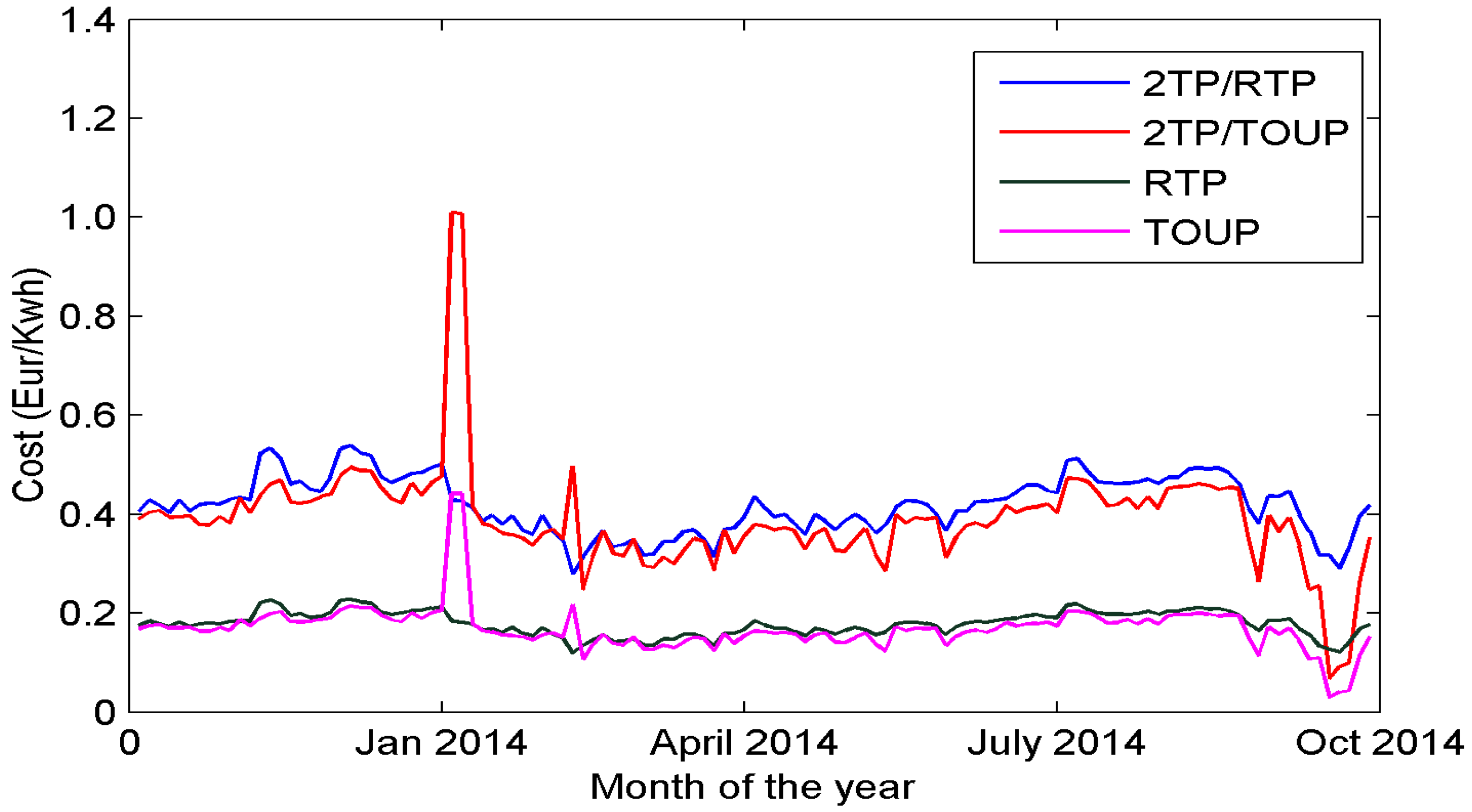
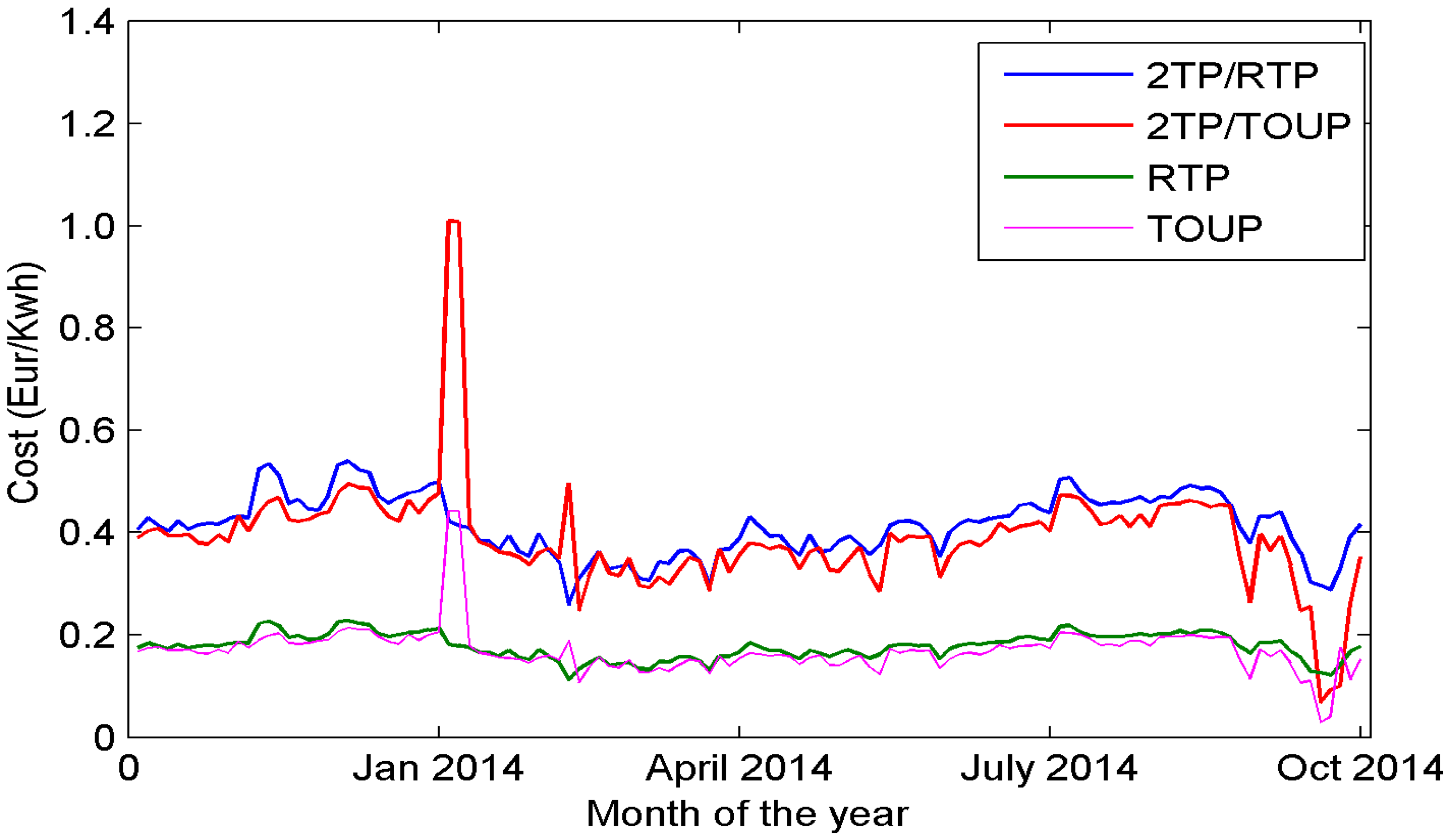
5.3. Power Consumption for Real-Time Energy Pricing (RTP) and Two-Tier Pricing (2TP) with Heuristic and Exact Algorithms
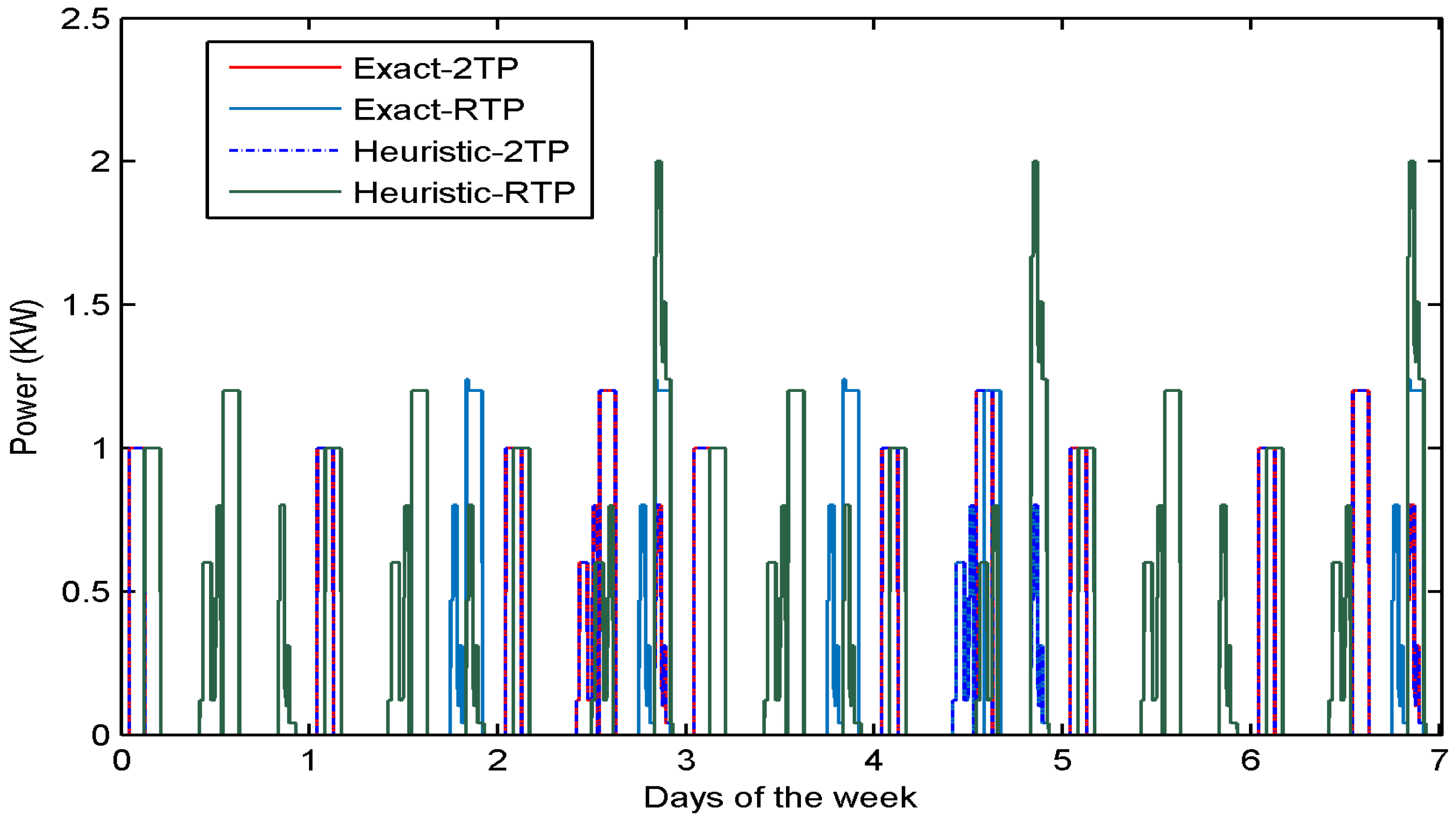
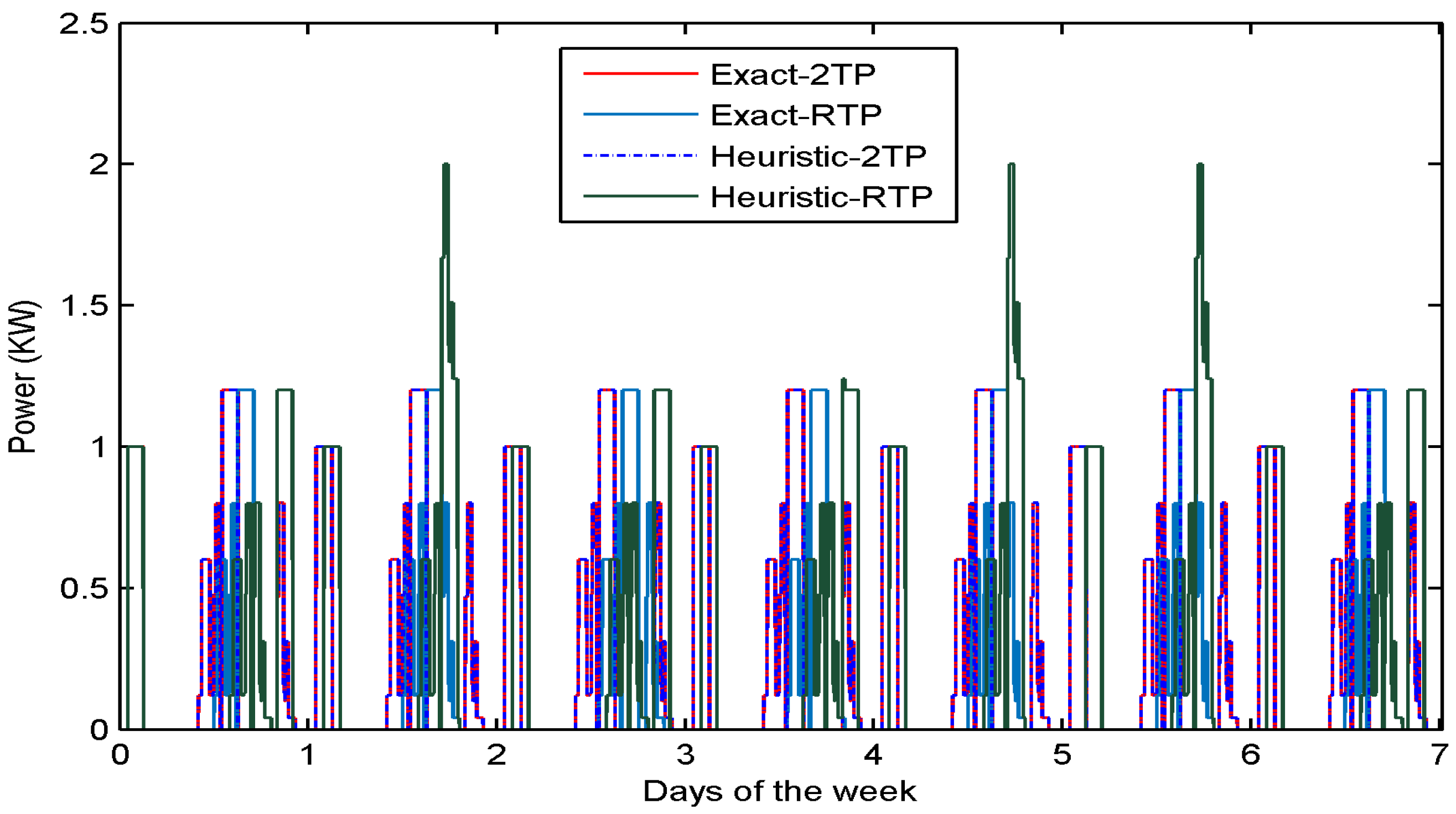
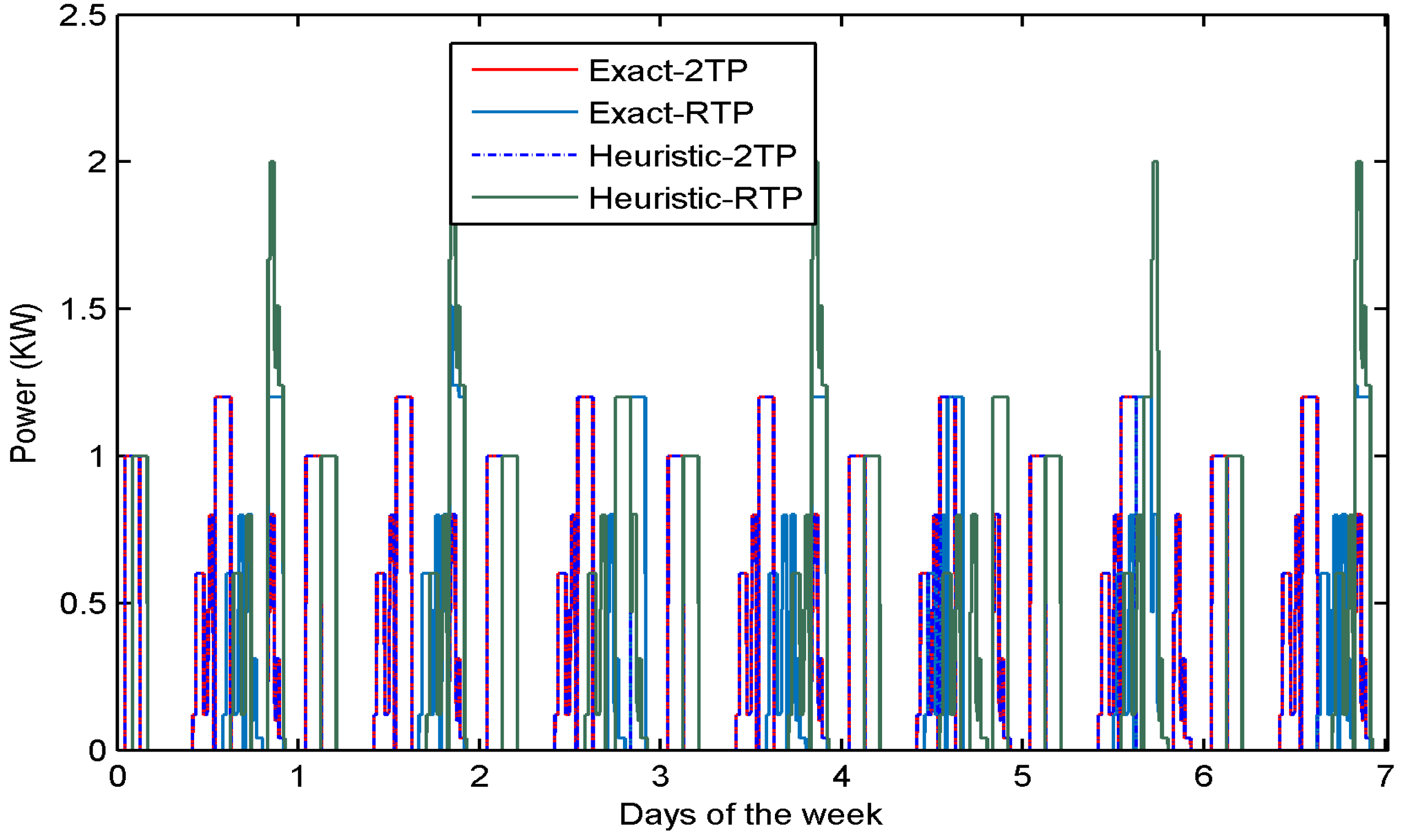
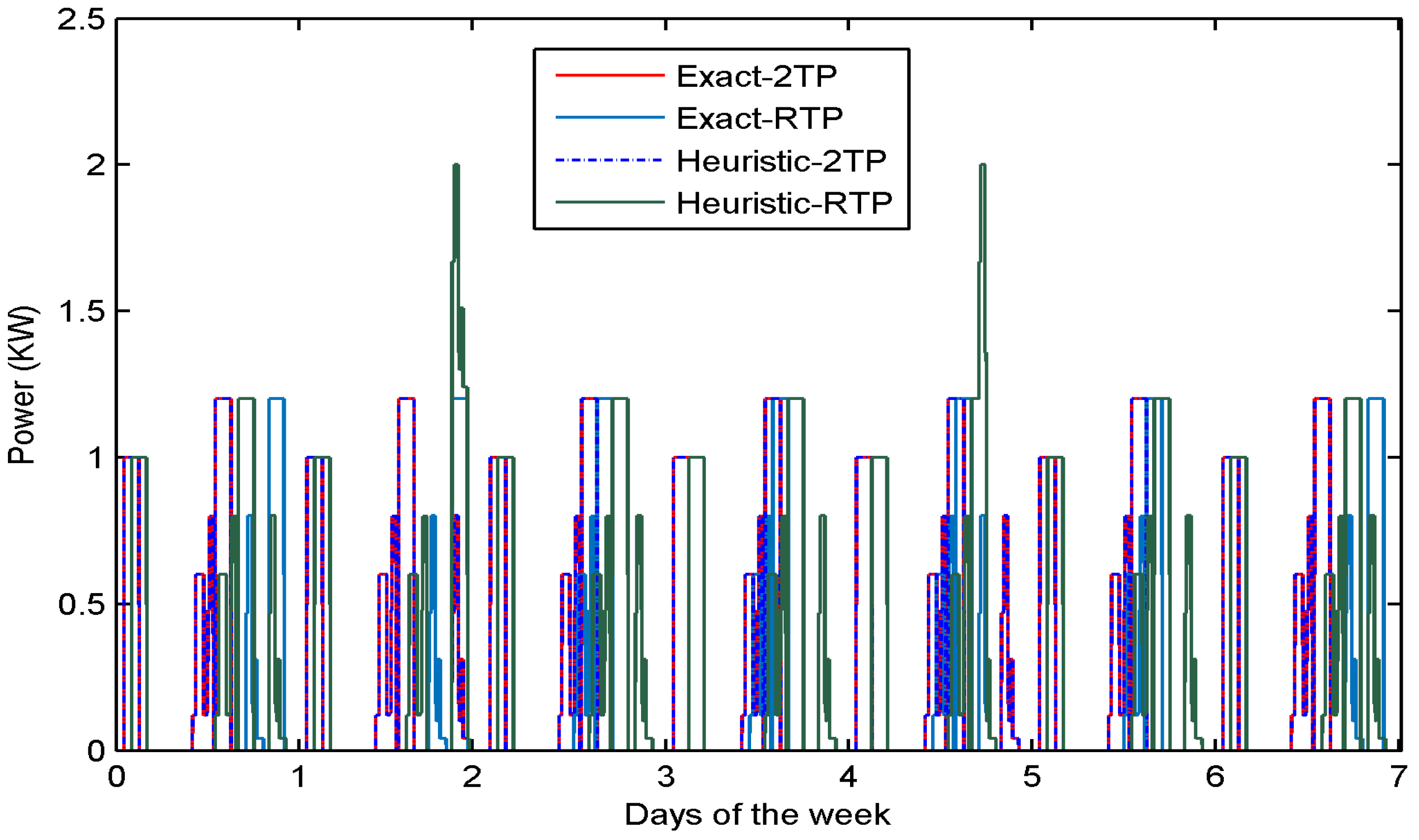
6. Cost Evaluation Based on Multiple Household Configurations
| Average Yearly Total Cost (Eur/kWh) | Five Appliances with Configurations (C1~C4) | Six Appliances with Configurations (C5~C8) | ||||||
|---|---|---|---|---|---|---|---|---|
| C1 RTP | C2 RTP/2TP | C3 TOUP | C4 TOUP/2TP | C5 RTP | C6 RTP/2TP | C7 TOUP | C8 TOUP/2TP | |
| Heuristic algorithm | 0.2071 | 0.4763 | 0.3043 | 0.5123 | 0.2276 | 0.4829 | 0.2117 | 0.4781 |
| Exact algorithm | 0.2068 | 0.4722 | 0.3037 | 0.5111 | 0.2273 | 0.4790 | 0.2087 | 0.4758 |
| % Difference | 0.0014 | 0.0086 | 0.0019 | 0.0023 | 0.0013 | 0.0080 | 0.0142 | 0.0048 |
7. Conclusions
Author Contributions
Conflicts of Interest
Appendix A
Appendix B
| Devices | Input Parameters | Household Configuration | |||
|---|---|---|---|---|---|
| C1 RTP | C2 RTP/2TP | C3 TOUP | C4 TOUP/2TP | ||
| Washing Machine | Start time Range | 10~20 | 10~20 | 10~20 | 10~20 |
| Timeslot Lenght | 136 | 161 | 130 | 154 | |
| Power | 2249.96 | 2249.96 | 2249.96 | 2149.96 | |
| Dish washer | Start time Range | 9~23 | 9~23 | 9~23 | 9~23 |
| Timeslot Lenght | 82 | 134 | 78 | 87 | |
| Power | 1739.96 | 1880.96 | 1740.96 | 1840.96 | |
| Tumble dryer | Start time Range | 13~23 | 13~23 | 13~23 | 13~23 |
| Timeslot Lenght | 90 | 120 | 105 | 70 | |
| Power | 1200 | 1200 | 1500 | 1200 | |
| Electric vehicle | Start time Range | 1~6 | 1~6 | 1~6 | 1~6 |
| Timeslot Lenght | 120 | 110 | 150 | 120 | |
| Power | 1100 | 1000 | 2500 | 2000 | |
| Water heater | Start time Range | 5~20 | 5~20 | 5~20 | 5~20 |
| Timeslot Lenght | 105 | 60 | 90 | 60 | |
| Power | 950 | 900 | 700 | 1000 | |
| Devices | Input Parameters | Household Configuration | |||
|---|---|---|---|---|---|
| C5 RTP | C6 RTP/2TP | C7 TOUP | C8 TOUP/2TP | ||
| Washing Machine | Start time Range | 10~20 | 10~20 | 10~20 | 10~20 |
| Timeslot Lenght | 135 | 135 | 155 | 135 | |
| Power | 1939.96 | 1899.96 | 2249.96 | 1899.96 | |
| Dish washer | Start time Range | 9~23 | 9~23 | 9~23 | 9~23 |
| Timeslot Lenght | 89 | 88 | 132 | 108 | |
| Power | 1720.96 | 1700 | 1960.96 | 1700 | |
| Tumble dryer | Start time Range | 13~23 | 13~23 | 13~23 | 13~23 |
| Timeslot Lenght | 90 | 90 | 90 | 90 | |
| Power | 1100 | 1000 | 1100 | 1000 | |
| Electric vehicle | Start time Range | 1~6 | 1~6 | 1~6 | 1~6 |
| Timeslot Lenght | 120 | 120 | 120 | 110 | |
| Power | 1500 | 1200 | 1000 | 1300 | |
| Water heater | Start time Range | 5~20 | 5~20 | 5~20 | 5~20 |
| Timeslot Lenght | 90 | 90 | 90 | 90 | |
| Power | 900 | 900 | 900 | 900 | |
| Electric cooker | Start time Range | 6~22 | 6~22 | 6~22 | 6~22 |
| Timeslot Lenght | 75 | 75 | 75 | 75 | |
| Power | 600 | 600 | 600 | 600 | |
References
- ERGEG (European Regulators’ Group for Electricity and Gas). Position Paper on Smart Grids. An ERGEG Conclusions Paper. Ref: E10-EQS-38-05. Available online: http://www.energy-regulators.eu/portal/page/portal/EER_HOME/EER_PUBLICATIONS/CEER_PAPERS/Electricity/2010/E10-EQS-38-05_SmartGrids_Conclusions_10-Jun-2010_Corrigendum.pdf (accessed on 12 June 2013).
- Khomani, H.P.; Javidi, M.H. An efficient home energy management system for automated residential demand response. In Proceedings of the 13th International Conference on Environmental and Electrical Engineering, Wroclaw, Poland, 1–3 November 2013; pp. 307–313.
- Logenthiran, T.; Srinivasan, D.; Shun, T.Z. Demand side management in smart grid using heuristic optimization. IEEE Trans. Smart Grid 2012, 3, 1244–1252. [Google Scholar] [CrossRef]
- Conejo, A.J.; Morales, J.M.; Baringo, L. Real-time demand response model. IEEE Trans. Smart Grid 2012, 1, 236–242. [Google Scholar] [CrossRef]
- Bradac, Z.; Kaczmarczyk, V.; Fiedler, P. Optimal scheduling of domestic appliances via MILP. Energies 2014, 8, 217–232. [Google Scholar] [CrossRef]
- Agnetis, A.; de Pascale, G.; Detti, P.; Vicino, P.A. Load scheduling for household energy consumption optimization. IEEE Trans. Smart Grid 2013, 4, 2364–2373. [Google Scholar] [CrossRef]
- Rothberg, E. An evolutionary algorithm for polishing mixed integer programming solutions. INFORMS J. Comput. 2010, 19, 534–541. [Google Scholar] [CrossRef]
- Ng, K.; Sheblé, G. Direct load control—A profit based load management using linear programming. IEEE Trans. Power Syst. 1998, 13, 688–694. [Google Scholar] [CrossRef]
- Somol, P.; Pudil, P.; Kittler, J. Fast branch and bound algorithms for optimal feature selection. IEEE Trans. Pattern Anal. Mach. Intel. 2004, 26, 900–912. [Google Scholar] [CrossRef] [PubMed]
- Fisher, N.; Baker, T.P.; Baruah, S. Algorithms for determining the demand-based load of a sporadic task system. In Proceedings of the 2006 12th IEEE International conference on Embedded and Real Time Computing Systems and Applications, Sydney, Australia, 16–18 August 2006; pp. 135–146.
- Pedrasa, M.A.A.; Spooner, T.D.; Macgill, I.F. Coordinated scheduling of residential distributed energy resources to optimize smart home energy services. IEEE Trans. Smart Grid 2010, 1, 1244–1252. [Google Scholar] [CrossRef]
- Ting, T.O.; Rao, M.V.; Loo, K.C. A novel approach for unit commitment problem via an effective hybrid particle swarm optimization. IEEE Trans. Power Syst. 2006, 21, 411–418. [Google Scholar] [CrossRef]
- Shah, A.; Kotecha, K. Scheduling algorithm for real-time operating system using ACO. In Proceedings of the 2010 IEEE Computation Intelligence and Communication Networks (CICN), Bhopal, India, 26–28 November 2010; pp. 617–621.
- Ferreira, F.A.; Lemos, F.A.B. Unbalanced electrical distribution network reconfiguration using simulated annealing. In Proceedings of the 2010 IEEE/PES Transmission and Distribution Conference and Exposition: Latin America (T&D-LA), Sao Paulo, Brazil, 8–10 November 2010; pp. 732–737.
- Rudolf, A.; Bayrleithner, R. A genetic algorithm for solving the unit commitment problem of a hydro-thermal power system. IEEE Trans. Power Syst. 1999, 14, 1460–1468. [Google Scholar] [CrossRef]
- Ko, M.J.; Kim, Y.S.; Chung, M.H.; Jeon, H.C. Multi-objective design for a hybrid energy system using genetic algorithm. Energies 2015, 8, 2924–2949. [Google Scholar] [CrossRef]
- Agrawal, P.; Rao, S. Energy-aware scheduling of distributed systems. IEEE Trans. Autom. Sci. Eng. 2014, 11, 1163–1175. [Google Scholar] [CrossRef]
- Pipattanasomporn, M.; Kuzlu, M.; Rahman, S. An algorithm for intelligent home energy management and demand response analysis. IEEE Trans. Smart Grid 2012, 3, 2166–2173. [Google Scholar] [CrossRef]
- Kong, P.Y. Effects of communication network performance on dynamic pricing in smart power grid. IEEE Syst. J. 2014, 8, 533–541. [Google Scholar] [CrossRef]
- Hansen, T.M.; Roche, R.; Suryanarayanan, S.; Maciejewski, A.; Siegel, H.J. Heuristic optimization for an aggregator-based resource allocation in the smart grid. IEEE Trans. Smart Grid 2015, 6, 1785–1794. [Google Scholar] [CrossRef]
- Ogwumike, C.; Short, M.; Denai, M. Near-optimal scheduling of residential smart home appliances using a heuristic approach. In Proceedings of the 2015 IEEE Conference on Industrial Technology, Seville, Spain, 17–19 March 2015; pp. 3128–3133.
- Ogwumike, C.; Short, M. Evaluation of heuristic approach for efficient scheduling of residential smart home appliances. In Proceedings of the IEEE 15th International Conference on Environmental and Electrical Engineering, Rome, Italy, 10–13 June 2015.
- Yang, L.; Zhihua, W. The implementation of peak and valley time price for electricity and the response of large industries. Autom. Electr. Power Syst. 2001, 25, 45–48. [Google Scholar]
- C simPLEX CPLEX Optimization, Inc. Using the CPLEX Callable Library and CPLEX Mixed Integer; Incline Village: Washoe County, NV, USA, 2007. [Google Scholar]
- Cheong Sou, K.; Weimer, J.; Sandberg, H.; Johansson, K.H. Scheduling smart home appliances using mixed integer linear programming. In Proceedings of the 50th IEEE Conference on Decision Control and European Control Conference, Orlando, FL, USA, 12–15 December 2011; pp. 5144–5149.
- Thakoor, N.; Gao, J. Branch and bound for model selection and its computational complexity. IEEE Trans. Knowl. Data Eng. 2010, 23, 655–668. [Google Scholar] [CrossRef]
- Garey, M.R.; Johnson, D.S. Computers and Intractability: A Guide to the Theory of NP-Completeness; W.H. Freeman and Company: New York, NY, USA, 1979. [Google Scholar]
- Nordpool Spot Prices. Available online: http://www.nordpoolspot.com/ (accessed on 10 May 2015).
- British Columbia Hydro Residential Usage Charge. Available online: https://www.bchydro.com/news/conservation/2012/kilowatt-hour-explained.html (accessed on 3 June 2015).
- Cheng Sou, K.; Kordel, M.; Wu, J.; Sandberg, H.; Johansson, K.H. Energy and CO2 efficient scheduling of smart home appliances. In Proceedings of European Control Conference (ECC), Zurich, Switzerland, 17–19 July 2013; pp. 4051–4058.
© 2015 by the authors; licensee MDPI, Basel, Switzerland. This article is an open access article distributed under the terms and conditions of the Creative Commons by Attribution (CC-BY) license (http://creativecommons.org/licenses/by/4.0/).
Share and Cite
Ogwumike, C.; Short, M.; Abugchem, F. Heuristic Optimization of Consumer Electricity Costs Using a Generic Cost Model. Energies 2016, 9, 6. https://doi.org/10.3390/en9010006
Ogwumike C, Short M, Abugchem F. Heuristic Optimization of Consumer Electricity Costs Using a Generic Cost Model. Energies. 2016; 9(1):6. https://doi.org/10.3390/en9010006
Chicago/Turabian StyleOgwumike, Chris, Michael Short, and Fathi Abugchem. 2016. "Heuristic Optimization of Consumer Electricity Costs Using a Generic Cost Model" Energies 9, no. 1: 6. https://doi.org/10.3390/en9010006
APA StyleOgwumike, C., Short, M., & Abugchem, F. (2016). Heuristic Optimization of Consumer Electricity Costs Using a Generic Cost Model. Energies, 9(1), 6. https://doi.org/10.3390/en9010006








